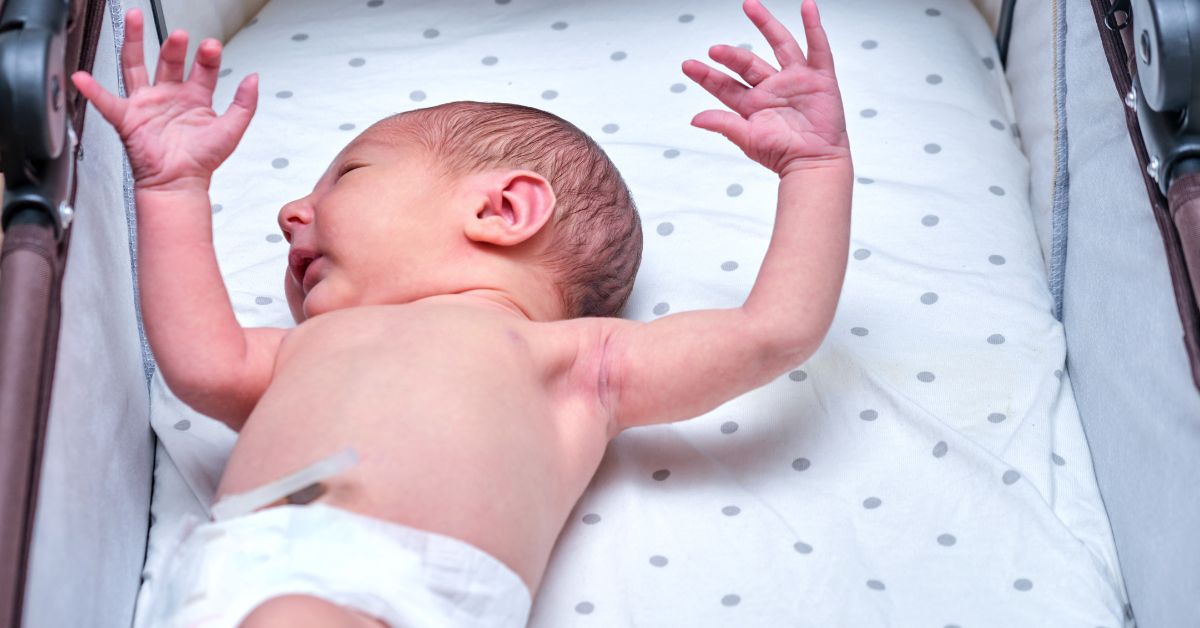Moro Reflex (Startle Reflex) in Newborn Babies, Triggers and More


Overview
Parents may observe their babies get startled or instantly react if they try to make them sleep. The movement is the Moro reflex, more commonly known as the startle reflex. It is an involuntary motor response that babies develop shortly after birth. It is also one of the things the doctor examines immediately after birth and during health checks.
This blog comprehensively explains a Moro reflex, how doctors identify it, and its triggers.
How do doctors identify the Moro reflex?
Reflexes are involuntary actions that the body automatically does without the person initiating it . Newborn babies are born with many necessary reflexes, known as primitive reflexes, which are crucial for their development. Some reflexes are responses to actions, whereas others are spontaneous movements.
Babies display many instinctive reflexes, such as rooting, sucking, grasping, and stepping. Doctors examine for these reflexes when parents visit the doctor for post delivery health checks. Newborn babies display the Moro reflex as an automatic response when startled.
A Moro reflex usually occurs if babies are startled by a loud sound or movement. When there is a loud sound, babies throw back their heads, extend their arms and legs, cry, and then pull their arms and legs back in response to the sound.
The Moro reflex lasts until babies are about two months old. Some babies will have an abnormal Moro reflex involving only one side of their body, whereas others may not have any Moro reflex. Some of the possible causes of an abnormal or absent Moro reflex include:
When should parents call the doctor?
Parents and caregivers suspecting their baby to have exaggerated or absent Moro reflex can contact their doctor.
Request an appointment at Apollo Hospitals
How should parents calm the baby when they have the Moro flex?
Even though the Moro reflex is a good sign for newborn babies, some may have an overactive or exaggerated Moro reflex that may sometimes hamper their sleep. In extremely rare cases, a severe Moro reflex could signify hyperekplexia (an inherited neurological condition). Infants with hyperekplexia have exaggerated startle responses, followed by muscle rigidity and paralysis for short periods.
Babies may also suffer from hypertonia, a condition in which increased muscle tone makes the limbs stiff and difficult to move. Parents can consult the doctor if they observe these symptoms in their babies.
Parents need to remember that the Moro reflex is not a cause for concern because it is a normal reaction in healthy babies. The Moro reflex is particularly strong in newborn babies as they adapt to the environment outside the womb.
Parents and caregivers can comfort crying and distressed babies when they experience the Moro reflex by:
- Lowering the baby horizontally into their crib to prevent the baby from tilting its head backwards
- Keeping the baby close to them till they calm down
- Supporting the baby’s head and neck if they move or hold them.
- Moving the baby’s overextended arms and legs towards their body
- Swaddling the baby in a swaddling cloth since it secures their arms and legs and prevents the baby from moving
Conclusion
Loud noises or an instant change of light may startle a baby. In such instances, babies can respond by moving their heads back, stretching their arms and legs, and settling in the fetal position. Doctors call this involuntary reaction as the Moro reflex. Parents and caregivers can become anxious if they see the Moro reflex for the first time. However, the Moro reflex is a normal reaction in healthy babies. It reduces once babies can hold up their heads without support when they are four months old.
Frequently Asked Questions (FAQs)
1. What is the effect of age on the Moro reflex?
Babies have the Moro reflex when they are born. In the first twelve weeks after birth, babies can display a full Moro reflex involving the arms, legs, and head. Once the baby’s neck can support the weight of the head, it will reduce to less intense Moro reflexes. It usually happens when they are four months old. Babies may only stretch and curl their arms without moving the head or legs. The Moro reflex completely disappears when the baby is six months old.
2. What are the triggers of the Moro reflex?
Some factors triggering a Moro reflex in babies include loud noises, intense light, and instant movements. Babies can trigger a Moro reflex by themselves if they suddenly move.
If babies feel that they are falling when laid down or picked up, it can trigger a Moro reflex. Doctors can use the head drop method to examine for the Moro reflex. In a head drop test, the doctor stimulates the falling sensation by mildly lowering the baby’s head relative to the body.
© Copyright 2024. Apollo Hospitals Group. All Rights Reserved.
 +91 8069991061
Book Health Check-up
+91 8069991061
Book Health Check-up







